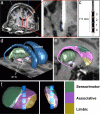Stimulation of subterritories of the subthalamic nucleus reveals its role in the integration of the emotional and motor aspects of behavior
- PMID: 17556546
- PMCID: PMC1965569
- DOI: 10.1073/pnas.0610849104
Stimulation of subterritories of the subthalamic nucleus reveals its role in the integration of the emotional and motor aspects of behavior
Abstract
Two parkinsonian patients who experienced transient hypomanic states when the subthalamic nucleus (STN) was stimulated during postoperative adjustment of the electrical parameters for antiparkinsonian therapy agreed to have the mood disorder reproduced, in conjunction with motor, cognitive, and behavioral evaluations and concomitant functional neuroimaging. During the experiment, STN stimulation again induced a hypomanic state concomitant with activation of cortical and thalamic regions known to process limbic and associative information. This observation suggests that the STN plays a role in the control of a complex behavior that includes emotional as well as cognitive and motor components. The localization of the four contacts of the quadripolar electrode was determined precisely with an interactive brain atlas. The results showed that (i) the hypomanic state was caused only by stimulation through one contact localized in the anteromedial STN; (ii) both this contact and the contact immediately dorsal to it improved the parkinsonian motor state; (iii) the most dorsal and ventral contacts, located at the boundaries of the STN, neither induced the behavioral disorder nor improved motor performance. Detailed analysis of these data led us to consider a model in which the three functional modalities, emotional, cognitive, and motor, are not processed in a segregated manner but can be subtly combined in the small volume of the STN. This nucleus would thus serve as a nexus that integrates the motor, cognitive, and emotional components of behavior and might consequently be an effective target for the treatment of behavioral disorders that combine emotional, cognitive, and motor impairment.
Conflict of interest statement
The authors declare no conflict of interest.
Figures




References
-
- Dalgleish T. Nat Rev Neurosci. 2004;5:583–589. - PubMed
-
- Alexander GE, DeLong MR, Strick PL. Annu Rev Neurosci. 1986;9:357–381. - PubMed
-
- Parent A, Hazrati LN. Brain Res Brain Res Rev. 1995;20:91–127. - PubMed
-
- Bartels A, Zeki S. NeuroReport. 2000;11:3829–3834. - PubMed
-
- Bhatia KP, Marsden CD. Brain. 1994;117:859–876. - PubMed
Publication types
MeSH terms
LinkOut - more resources
Full Text Sources
Other Literature Sources
Medical

